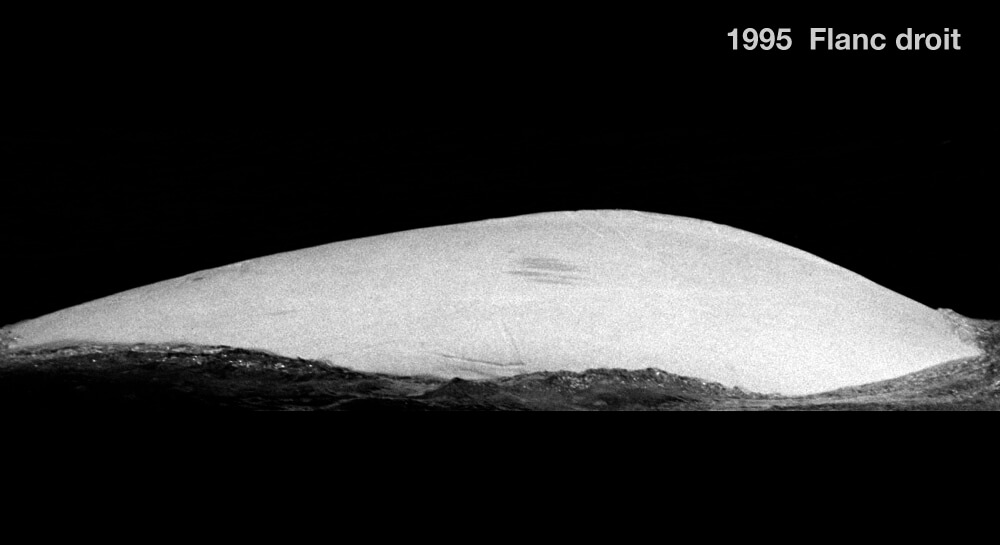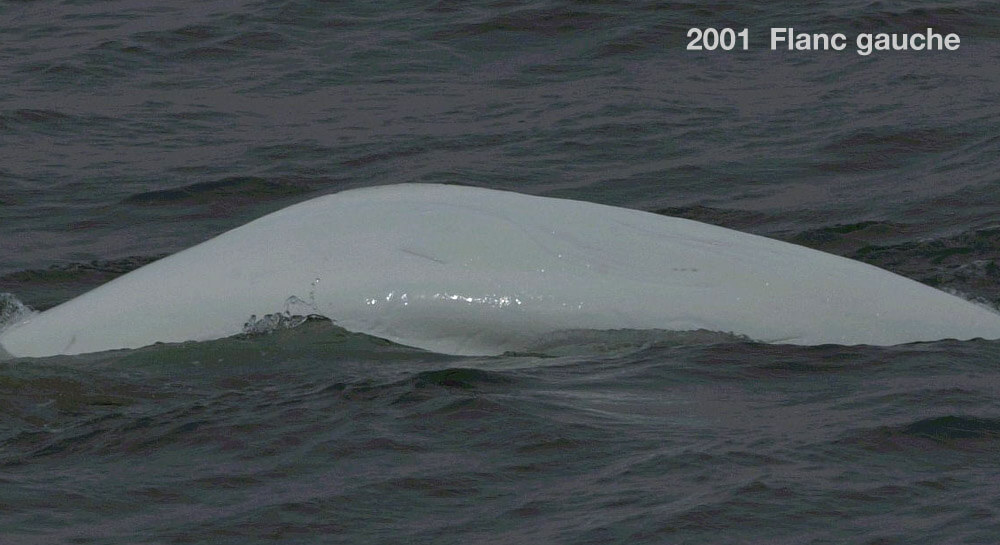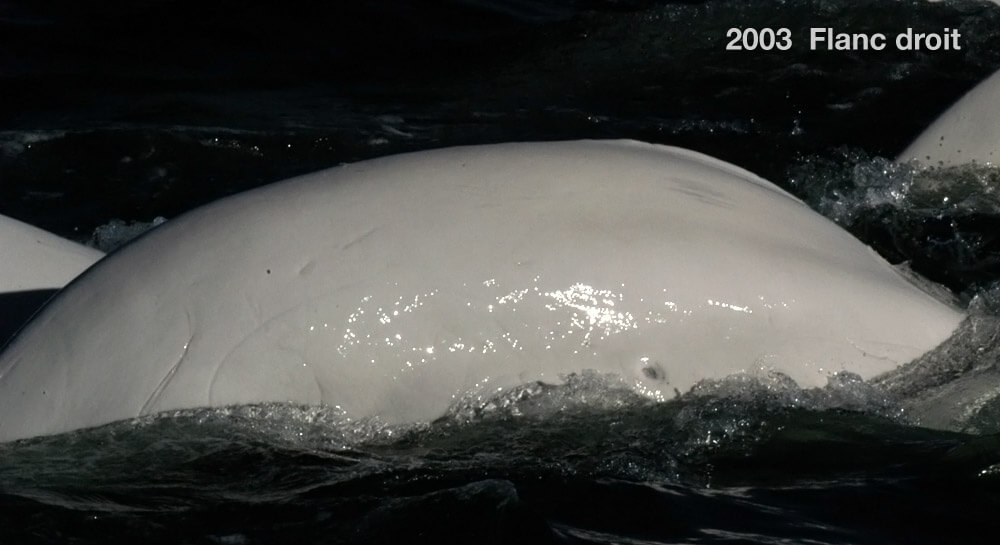Nikamun
Beluga


Adopted by Project Red Alert, Tadoussac
-
ID number
DL0269
-
Sex
Unknown
-
Year of birth
Around 1980
-
Known Since
1993
Distinctive traits
To recognize Nikamun from the left side, one needs to pay close attention to the small details of its dorsal crest. This beluga is much easier to identify from the right side thanks to a series of gray lines below the crest.
Life history
Nikamun was first photographed in 1993, at which time it was a young pale gray beluga. It turned white around 1995. Belugas fade from gray to white in colour between the ages of 12 and 16. Nikamun was thus born around 1980.
In summer, Nikamun is usually observed in the northern portion of the Estuary, between Tadoussac and Les Bergeronnes, or in the Saguenay River. It is regularly spotted in herds made up exclusively of adult males.
Its large size, habits and associations suggest that Nikamun is a male. It is a member of one of the two networks of bulls that regularly use the Saguenay Fjord. A third male network, the “Downstream Boys”, is known to use the same portion of the Estuary, but steers clear of the Saguenay. Even if their territories overlap, individuals from one network seldom come into contact with males of other networks.
Within these networks, belugas tend to form stable groups of companions. Nikamun’s most regular companions are DL0370, Jetstream and DL0248, three males that are often observed in the Saguenay. These associations, which are established gradually in adulthood, may play an important role in belugas’ reproductive lives.
How Nikamun’s story unfolds will teach us volumes on the evolution of belugas’ social lives. By better understanding how belugas live, we will be able to better protect them.
Observations history in the Estuary
Years in which the animal was not observed Years in which the animal was observed
Latest news
On board the BpJAM, the GREMM’s research craft, we set sail out of Tadoussac in search of belugas to photograph. We head down the St. Lawrence toward Les Escoumins. En route, we scan the surroundings in search of white backs. Finally, at 11:05 that morning we finally spot our first herd, which numbers between sixty and eighty individuals. The herd splits into smaller groups numbering about ten animals each. Nearly all of them are pure white, meaning they are adults. Thanks to our photos, we are able to identify Be-LOU-ga, Nikamun, DL0014 and DL0240, all of which are males. Be-LOU-ga and Nikamun have often been seen together over the years. Male belugas tend to form long-lasting associations, which might help them when it comes time to breed. Further research may help us shed more light on this question.
Last winter, our research assistants undertook the meticulous analysis of some 13,000 photos collected throughout the summer of 2018.Thanks to this exercise, we were able to conclude that we spotted Nikamun at least once. Here is a description of this encounter.
A gentle swell rocks the BpJAM off the coast of Trois-Pistoles. We are photographing the belugas and filming them with a drone in order to study their behaviour. A herd of fifteen or so individuals is swimming nearby. It is split into adult-juvenile pairs, with each duo a few metres away from the next. Individuals approach, pair up and go their separate ways up again, making it difficult to census the animals. Another herd of about fifteen belugas arrives; we count 10 adults and 4 greys swimming in tight formation. Amongst the adults, we recognize males Nikamun, DL0370, Mirapakon, DL0248 and Jetstream. The dynamics change, the belugas become more active and intermingle. We patiently learn to better understand Nikamun, his habits and who his acquaintances are.
Summer 2016, our 32nd season at sea with the belugas, was once again rich in encounters and surprises. Among other things, we saw Nikamun again on August 30, in a herd of males. This observation supports the idea that Nikamun is a male. Let’s hope that future sightings will enable us not only to confirm his sex, but also to discover his regular companions.
On August 30, 2016, we took advantage of fine weather conditions to visit the downstream sector where we regularly encounter flocks of males. We cross paths with Nikamun off Ile aux Basques. He’s in a herd of around sixty belugas, mostly adult males and a few gray individuals. The herd is divided into about ten groups of six to fifteen belugas. We also recognize the males JP, Douxi and DL0370.
The animals are scattered and very active. Some belugas stick their heads out at the surface, as if to spy on us, while others spit water. They swim dynamically and directionally, then suddenly stop, dive and swim back to the same spot several times. They’re probably feeding. The encounter with Nikamun is also rich in sound. We hear all kinds of vocalizations, door squeaks, whistles and more. The beluga lives up to its nickname, the canary of the sea!
We’re on the north shore of the Upper Estuary between Baie-Saint-Paul and Tadoussac. We observe a group of around 30 individuals, including adults and youngsters, including a newborn. However, the fog made it difficult to count the flock. We notice DL0248 in the company of another male, Nikamun. They are swimming close to two known females, Céline and Annakpok. The whole herd is very active : the belugas swim synchronously and suddenly stop, dive and swim back to the same spot several times. We can’t confirm this, but it’s probably feeding. Working conditions are difficult : the strong wind and rising waves make the task difficult. Nevertheless, we managed to take two biopsies from two individuals.
On July 31, 2013, we were sailing near the north shore of the Saguenay Fjord. We make contact with a herd of around twenty individuals. Most of them are young gray males known as “teens”. Nikamun is among them. As the morning goes by, the herd gets bigger and bigger : adult males, females and two calves join in, eventually numbering some forty individuals.
We recognize DL1881, designated as a “teenager”, Yogi, an adult female, DL0516, a young female, and DL0370 an adult male, Nikamun’s regular companion. The Saguenay is a place where the sexes and generations of belugas intermingle in summer : networks of males intermingle with communities of females and youngsters, including newborns, as well as groups of young males, the “teens”.
Sponsors
Project Red Alert, Tadoussac adopted Nikamun (2017).
Gwen Skutezky
The Winnifred Molson Conservation Foundation
Robert Farquharson
Thank you for your amazing contribution to whale research and for elevating Tadoussac to a centre of intellectual excellence in GREMM’s field of study.
John Leggat
Jessie Jamar
À la mémoire de Mariana Jamar
John Molson
Robert Stinson
In support of DLO269.
Minty Turcot
Sarah Stairs
Gail Skutezky
Protecting our belugas is essential. We are happy to do our part. Trevor and Gail Skutezky and Family.
Kimberly Milligan
Andrew Bruemmer
Anne Felicite Stairs
Joan and Charles Ballantyne
Jennifer Bruemmer
Katherine Bennett
In Memory of V. Ann Van Alstyne.
Wendy Turcot
Jane and Alan Evans
In Honour of our grandchildren Jayson, Rebecca and Edward.
Sue Bruemmer
The Bruemmer Family is happy to contribute to research being done to protect the beluga whales.
Maggie Campbell
Cynthia Price
Glynis Williams
In support of DL0269 (PROJECT RED ALERT, TADOUSSAC)
Susan Turcot
In Honour of Harrison Baker.
Catherine Williams
In Honour of William Phee.
Peggy Turcot
En l’honneur de Finn James McMartin Brown.
Timothy Russell Dewart
In Honour of The Reverend and Mrs. Russell Dewart.
Eve Wickwire
In Memory of Gordon Carington Smith.
Kenneth Campbell
In Honour of Tadoussac Families. Merci pour votre travail! Les Campbells.
Briony Glassco
In Honour of Bill Glassco.
Adelaide Park Gomer
Kevin Dillon
Ruth Skutezky
À la mémoire d’Ernest & Phoebe Skutezky.
Isabel Corrigan
Virginia Bell
What a great project to save our belugas.
Alan Dewart
À la mémoire de Rums.
Frances Price
Anne Turcot
Peter A. Turcot
Sheila E. Campbell
Eric Vernassiere
Pour la protection des bélugas du Saint-Laurent et du fjord du Saguenay, avec toutes nos amitiés !
Clémence Berger
Bonjour, nous parrainons ce béluga en l’honneur de Clémence, notre soeur qui fête ses 30 ans et est passionnée des bélugas ! Merci pour vos travaux de recherche sur les mammifères marins ! Juliette et Leïla.




